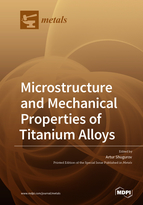Microstructure and Mechanical Properties of Titanium Alloys
A special issue of Metals (ISSN 2075-4701).
Deadline for manuscript submissions: closed (31 March 2021) | Viewed by 40030
Special Issue Editor
Interests: titanium alloys; thin films and coatings; mechanical properties; scratch testing; nanoindentation; surfaces and interfaces
Special Issues, Collections and Topics in MDPI journals
Special Issue Information
Dear Colleagues,
Titanium and its alloys are widely used engineering materials within the Aerospace, Automotive, Energy and Chemical industries. Their unique combinations of high strength-to-weight ratio, strong resistance to creep, excellent corrosion resistance, and low heat conductivity make them suitable for a wide range of applications. A large variety of microstructures, including lamellar, martensite, equiaxed globular and bimodal (duplex) microstructures can be obtained in titanium alloys depending on the thermomechanical processing routes. Despite a large amount of work in the field of investigation of microstructure evolution and mechanical properties of titanium alloys, detailed studies of the effect of their microstructure on the mechanical behavior are still necessary because of ever-increasing demands for structural materials to optimize their properties for different applications by varying processing parameters and resulting microstructures.
This Special Issue is focused on various aspects of microstructure evolution in titanium alloy samples obtained using traditional and additive technologies and subjected to different processing techniques as well as on the relation between their microstructure and mechanical behavior. Reviews and original articles in the areas of preparation and experimental characterization of titanium alloys as well as computer simulation of their mechanical behavior under different loading conditions are welcomed.
Prof. Dr. Artur Shugurov
Guest Editor
Manuscript Submission Information
Manuscripts should be submitted online at www.mdpi.com by registering and logging in to this website. Once you are registered, click here to go to the submission form. Manuscripts can be submitted until the deadline. All submissions that pass pre-check are peer-reviewed. Accepted papers will be published continuously in the journal (as soon as accepted) and will be listed together on the special issue website. Research articles, review articles as well as short communications are invited. For planned papers, a title and short abstract (about 100 words) can be sent to the Editorial Office for announcement on this website.
Submitted manuscripts should not have been published previously, nor be under consideration for publication elsewhere (except conference proceedings papers). All manuscripts are thoroughly refereed through a single-blind peer-review process. A guide for authors and other relevant information for submission of manuscripts is available on the Instructions for Authors page. Metals is an international peer-reviewed open access monthly journal published by MDPI.
Please visit the Instructions for Authors page before submitting a manuscript. The Article Processing Charge (APC) for publication in this open access journal is 2600 CHF (Swiss Francs). Submitted papers should be well formatted and use good English. Authors may use MDPI's English editing service prior to publication or during author revisions.
Keywords
- Titanium alloys
- Plastic Deformation
- Microstructure
- Phase transformations
- Mechanical characterization
- Computer simulation
Related Special Issue
- Microstructure and Mechanical Properties of Titanium Alloys II in Metals (3 articles)






